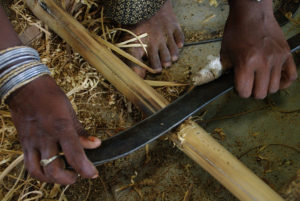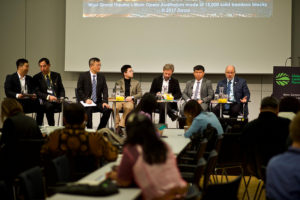Can grass be used to make tissues, furniture, pipes and even housing? Can it help to improve livelihoods and to mitigate climate change? Think beyond garden lawns and savannah landscapes, to bamboo.
“Bamboos, although they look like trees,” said the International Bamboo and Rattan Organisation’s (INBAR) Director General Hans Friederich in opening a recent side event at the Global Landscapes Forum (GLF) in Bonn, Germany, “are actually all grass species.”
Bamboo provides a durable building material and strong fiber for paper and textiles without the need to fell trees. Additionally, Friederich explained that as a grass, bamboo grows back quickly after being harvested – making it a highly sustainable product to work with.
Titled Bamboo for restoration and economic development, the discussion addressed how bamboo fits into conversations about land management, land restoration, erosion control and nature-based solutions for development challenges.
“[We need to] make that connection between bamboo as a plant, as a means to hold soil together, to think about climate change mitigation […] and then link that to the market,” he said. “What actually can we do with this bamboo once we plant it?”
“To have a value chain that actually identifies the market opportunities is important,” he added.
Eduardo Mansur, director of land and water at the Food and Agriculture Organization of the United Nations (UN) underlined the importance of nature-based solutions, and combining green and grey infrastructure – that is, natural ecosystems with human-engineered solutions.
He described the huge amount of degraded land on the planet, saying: “If we restore this degraded land that exists on the planet […] we will be able to produce the products, the food and the ecosystem services that we need for sustainable livelihoods and sustainable life on the planet.”
“We have seen examples of species-specific conservation,” he said, “when it links with sustainable livelihoods.” Giving the example of the Brazilian Amazon, Mansur described a species of palm that produces an inedible coconut known as “vegetable ivory” for its color and texture. Used to make buttons and handicrafts, it has helped to improve the ecosystems where the palm occurs, he said, because there is a market link.
Such a species can be used to promote sustainable livelihoods and sustainable use, he added, drawing a comparison with the over 1,600 species of bamboo. If a bamboo species is well chosen and well managed, it can have ongoing positive effects, especially for soil restoration.
Read also: Bamboo and rattan: Surprising tools for forest protection
Ye Ling, president and chief engineer at Zhejiang Xinzhou Bamboo-based Composites Technology Co., Ltd, discussed how his company develops products from bamboo on a large scale – such as pressure pipes and modular housing from a bamboo composite – which offer better performance and lower costs and can replace a huge quantity of traditional materials such as cement and steel, thus helping to tackle climate change and contributing to the SDGs.

He emphasized innovation as the most important factor in product development, saying that without it, other factors such as policy or investment would have nowhere to go.
Trinh Thang Long, coordinator of the Global Assessment of Bamboo and Rattan for green development (GABAR) at INBAR said the organization’s 44 member states had begun to learn specifically from China’s use of bamboo for economic development.
GABAR aims to maximize bamboo and rattan’s contribution to national economic development and environmental protection, to help inform policies, development strategies and opportunities for investment.
Many countries are not yet fully aware of the advantages of bamboo compared to trees, Long explained. He emphasized that the grasses are fast growing, easy to manage, and can be harvested annually after the first four to five years.
INBAR’s member states are contributing to the Bonn Challenge by restoring 5 million hectares of degraded land using bamboo. On a small scale, the work has been successful, but upscaling remains a challenge.
This challenge affects many countries, but a case study in China illustrates the success of scaled-up bamboo. Jiang Jingyan, President of Yong’an Institute of Bamboo Industry, discussed Yong’an, China, and its reputation as a “bamboo city”. Concurring with previous speakers, he also addressed the importance of design and innovation.
The CGIAR Research Program on Forests, Trees and Agroforestry’s (FTA) Director Vincent Gitz then spoke about land restoration and the key constraints to upscaling, including policies and governance. He gave special attention to the economic aspects of land restoration – costs and benefits, investments and value chains.
“There won’t be any sustainable land restoration if we don’t give the means to increase, over time, the livelihoods of people that live on those lands,” he said.
There is often a time lag between a smallholder making an investment and seeing a return. However, as bamboo grows quickly and is extremely versatile, it is a strong option for restoration in different contexts. “Lots of innovation can come out of this plant,” he added.

An additional step is using bamboo to restore degraded lands while simultaneously creating clean energy, Gitz said, referring to an initiative from Clean Power Indonesia, which FTA is part of, and which is building small-scale bamboo-based energy generation plants in West Sumatra.
Touching further on industrial development, Cai Liang, the chief branding officer of Vanov Bamboo Tissue Enterprise in Sichuan, China, discussed the use of bamboo pulp for paper manufacturing, specifically for tissues. From concept to commitment, the company moved to develop a tissue paper using bamboo, without cutting down a single tree.
After years of experimentation, the company came up with soft, unbleached, antibacterial tissues made from bamboo fiber. Once again highlighting bamboo’s short growth period, constant regeneration and sustainability, Liang described how bamboo could provide the fibers typically taken from multiple types of trees to make paper.
Read also: Study examines bamboo value chains to support industry growth
As well as using the fiber to make the tissues themselves, the company uses waste from the process for energy generation and for fertilizer. The low-emission, closed-loop model uses over 1 million tons of bamboo annually, and offers over 1 million job opportunities for local farmers.
In closing, Friederich underscored this link between restoration and socioeconomics, harking back to Gitz’s presentation.
“If we want to succeed in restoration, we cannot only look at the landscapes – of course we need to look at the landscapes – but we need to look at the people in the landscapes and to connect them with the value chains that can come out of the productive aspects of restoration,” Gitz said.
“We can’t just stay where we are, and I think there are still some great opportunities for making new products from bamboo and looking at new ways of using bamboo within the landscape,” Friederich added.
By Hannah Maddison-Harris, FTA Communications and Editorial Coordinator.
Read more about INBAR’s participation in GLF Bonn 2018, or check out the summary of discussions from the forum.











